The animal on the right page is not a snake but a tiny caterpillar, simply a tiny "caterpillar". This animal protects itself from its enemies by its similarity to a snake. When attacked by an enemy, this tiny creature calmly turns its tail towards its enemy and puffs it up. At that moment, a dreadful snake shows up right in the face of the enemy, which has no other choice than to run away and save itself.
The caterpillar’s tail looks so much like a snake that even the sparkle of the eye, within the dark spots that stand for the snake’s eyes, is not left out. As an extremely slow-mover and thus a very easy prey for its enemies, the caterpillar successfully escapes from many dangers owing to this extraordinary feature of its body.
How did the caterpillar acquire such a trait? Such a striking "design" must unquestionably have a satisfactory explanation. Now, let us examine the scenarios that could be fabricated as an answer to this question:
Scenario 1: Many years ago, a caterpillar looking for ways to protect itself from enemy attacks, started carefully observing its surroundings. It one day realised that all its enemies are afraid of snakes. At that moment, it looked at its body and decided to make it "look like" a snake. (We cannot provide an explanation as to how it would manage to make its body look like a snake’s, how it would set up its outward appearance, the colour of its skin and the shape of its body to look like a snake! Let us say that it would "do its best, force itself and, in the end, do something". It, however, had a very limited time to "change". For it would spend a very short time of its life as a caterpillar, and then it would become a butterfly and fly.
It is very important that nothing was left out as it "changed" its body, because it had only one chance to test its new tail. If the first trial was not successful and if it could not deceive its enemy, all its efforts would be wasted, and on top of that it would lose its life. Certainly, it had to survive during this self-re-construction process. However, chance was on its side and it did not fall prey to its enemies. Finally, it achieved the difficult task and "made" its tail look like a snake.
Scenario 2: trees, flowers, insects, the sky, water, rain, sun and, in brief, all powers prevalent on earth united to establish a system for themselves and simply added a tail to the caterpillar within this system!
Scenario 3: The great power called ‘coincidence’ (!) has added a snake-like tail to the caterpillar just as it gave various things to all living beings.
One does not have to be very intelligent to see the inconsistency in these scenarios, all based on the Theory of Evolution. Neither is the caterpillar an attentive and observant designer, nor has the earth itself a system that has the ability to design and create. In other words, neither can a living thing interfere in its own body to acquire advanced features or change itself into another species, nor is there a mechanism outside of it to do this. (This subject is described in detail in the chapter on the Theory of Evolution.)
 |
| This animal, which looks like a dreadful snake, is in fact nothing but a caterpillar that is only a few centimetres long. |
Those who regard nature as a highly skilled machine and believe such things as "nature discovered", "wonder of nature", "mother nature", etc., know very well that what they mean by "nature" is the air, water, earth, trees, flowers and insects. In short, they mean the whole world and the solar system in which our world is located. If people were told that all living things were "made by the world" or "produced by the earth", they would most probably laugh. However, propaganda using the words "nature-cosmos" makes people regard nature almost like a conscious being. One must not forget that nature is the name of the extraordinarily orderly and perfect system we view, not the name of its establisher and eternal life-bestower. Allah created all living beings on earth and they continue to live, along with whatever features Allah has endowed them.
In this chapter of the book, we are going to review the defence systems of some animals in nature. While doing this, we have to keep in mind a very important point: much of nature is based on a continuous relationship between living things that hunt and that are hunted. This relationship rests on such a delicate balance that for millions of years, millions of species have been feeding on other species, yet none of them have disappeared. If one of the important species within the hunting chain became extinct, a great discord would be aroused. For instance, if the anteater species became extinct, then ants would invade vast areas in a very short time.
This predator-prey relationship between living things is carried out in great harmony unless human beings intervene. The most important elements in the system that maintains the perpetuity of this balance are the hunting and defence mechanisms of these animals. In previous chapters, we saw that some animals are created with very extraordinary hunting skills and thus are "provided". If nature were full of living beings equipped with such aggressive systems, then they would excessively devour those animals on which they prey and cause them to be extinct. When those animals were exterminated, those who feed on them would starve and nature would end in total destruction.
 |
| Allah is the Creator of everything and He is Guardian over everything. |
However, this problem is already settled within the system Allah established. As "hunter" animals are equipped with perfect attack systems, prospective preys are also equipped with perfect defence systems. The skills of both sides balance each other. In addition, these extraordinary skills give man the opportunity to come to know the infinite might, wisdom and knowledge of Allah, the Creator of all these skills.
Every living being is brought into being with distinct skills to defend itself. Some are very swift; they can save themselves by running away. Some cannot move but are covered with strong armour. Some have amazing "fear-creating" skills like the caterpillar described earlier. Some pour poisonous, burning or stinking gasses on their enemies. Still others are endowed with the ability to pretend they are dead. There are yet others created with bodies that are extraordinarily suitable for camouflage.
In the following pages, we will examine some of the most amazing and striking examples of these defence systems. Needless to say, however, that these are only specific examples and other living beings are endowed with thousands of interesting systems that we cannot possibly mention here, some of which even are not yet discovered by mankind. All of these systems reveal that there is no "want of proportion" in the universe Allah created and that His power, wisdom and knowledge are boundless, as Allah mentions in Surat al-Mulk:
He Who created the seven heavens in layers. You will not find any flaw in the creation of the All-Merciful. Look again - do you see any gaps? Then look again and again. Your sight will return to you dazzled and exhausted! (Surat al-Mulk: 3-4)
Other than a few exceptions, most predators prefer live animals as bait. Carcass flesh is not preferred. This tendency forms the basis of the defence of some living species.
 |
| (Left) The Tiger moth fakes its death, too. It, however, has yet another tactic. When it falls on one side, its orange body is seen. This bright colour is a warning to the hunter, which implies that the moth tastes bad. The moth unquestionably has neither the wisdom to devise this "tactic", nor the skill to turn the colour of its body into a colour suggesting to the enemy that it tastes bitter. It is just created with this interesting skill.The Hognose snake protects itself by mimicking its death. It turns face upwards, opens its mouth and stays in this position without moving at all, like a dead snake. |
| (Right) In order to drive away animals heading for its offspring, the Rain Bird lowers one of its wings as if it was broken, and attracts the enemy towards itself by dragging its wing on the ground as if injured. It allows the enemy to follow it until the nest is fully secure. When it is fully convinced that the enemy is far enough from the nest, it stops play-acting and rushes back to its offspring. |
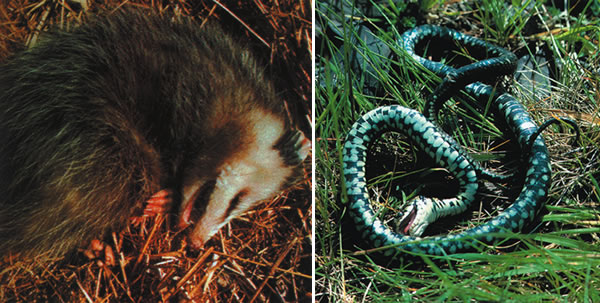 |
| (Left) The animal called Opossum is created in such a way as to protect itself by counterfeiting its death. Thinking it is just a carcass, its enemy disregards it. It acts out its role so well that its heartbeat slows down to the point of stopping. Its ability to slow its heartbeats is unquestionably not a skill the animal subsequently acquired, but one that was given to it during its creation. (Right) The Hognose snake protects itself by mimicking its death. It turns face upwards, opens its mouth and stays in this position without moving at all, like a dead snake. |
Some living beings can produce within their organisms quite complex chemical compounds, which if humans tried to make them would require very high technology and laboratory precision; the animals make them quite easily. Here are some of them:
The name of the animal you see in the picture is the "Bombardier Beetle". The defence method of this beetle is not like that of other animals. In moments of danger, a mixture of two chemicals (hydrogen peroxide and hydroquinone) that is previously stored in a storage chamber is transferred to an explosion chamber. With the accelerative effect of a special catalyst (peroxidase) secreted from the walls of the "explosion chamber", the mixture turns into a horrible chemical weapon at 100oC. Scalded by the boiling chemical substance squirted with pressure, the enemy panics and gives up the hunt.
If we look for an answer to the question "how did this extremely complex defence mechanism come into existence?", we see that it is impossible for this insect to have developed this mechanism "by itself".
How could an insect make the formulae for two different chemicals that explode on contact? Let us assume it did, how could it secrete and store these in its body? Let us assume it did, how could it form a storage chamber and an explosion chamber in its body for these chemicals? Even if it "achieved" all of these, how could it devise the formula of a catalyst that would speed up the reaction of these two chemicals? It must also, after all, insulate the walls of the "explosion room" and the walls of the channel through which it squirts the mixture with a flame-resistant alloy so as not to burn itself.
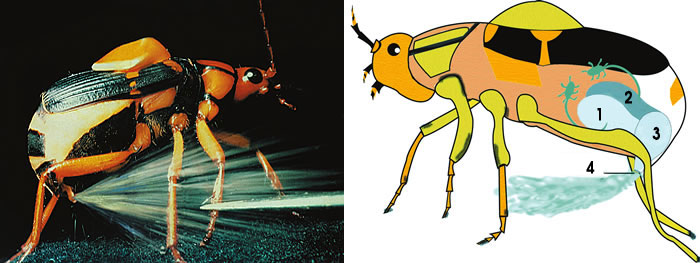 | |
| 1. Hydrogen Peroxide | 3. Explosion chamber |
The operations "performed" by the beetle cannot even be performed by human beings, with the exception of chemists. Unquestionably, chemists can perform such an operation not within their bodies, but only in laboratories!
It is certainly unreasonable to think that the beetle is such a specialised chemist and a miraculous designer as to be able to organise its body according to the reaction it will trigger. It is obvious that the beetle performs these operations only as a reflex, unaware of the outcome. No creature with such a superior power and wisdom exists in nature. Humans cannot make such a creature. Creating such a complex creature aside, scientists have not even been able to make a protein - one of the simplest foundational chemicals of life - although they have samples of it in their hand.
It is obvious that a being that has exalted knowledge and power - Allah - created the animal. The "Bombardier Beetle", just as billions of other things that are created, is only one example of His boundless power and matchless creation.
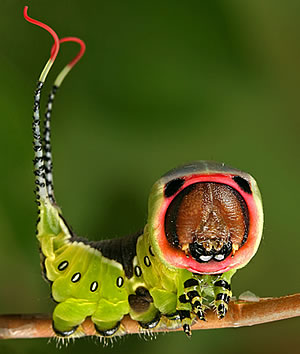 |
The Acidic Defence of The Red-Faced CaterpillarThe red-faced caterpillar, which has a similar defence system to that of the bombardier beetle, squirts an acid it produces in its own body at its attackers. It, too, just as the bombardier beetle, is not an extraordinary chemist, a magical biologist or a miraculous designer, but a "sign" created as an example of the existence and power of Allah. |
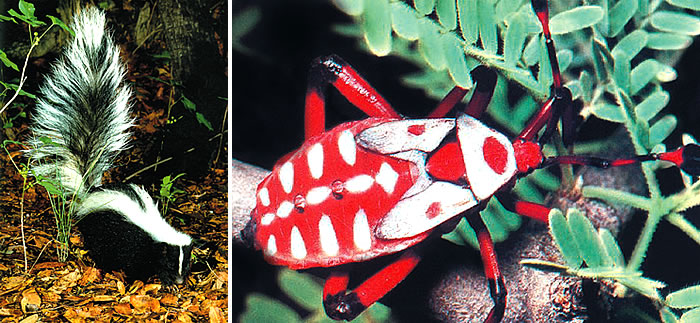 |
The Smell Bombs of The Skunk And Marrow BugThe sole feature of the chemical substance that skunks (on the left) squirt on their enemies is its awful smell. This disgusting and permanent smell is enough to protect them from their enemies. The marrow bug you see above is another animal with the same defence mechanism. |
 |
| The savage Aspidontus fish benefits from its resemblance to the Cleaner fish (in the picture below both are seen one on top of one another). It comes near to the fish that hope to be cleaned up and tears pieces from their tails and fins. |
 |
| The picture on the left belongs to a bee, and the middle belongs to a fly. Owing to this resemblance, enemies of the fly stay away from it thinking that it is a bee. In addition to the resemblance of the fly to the bee, it has also a buzzing feature just like bees. Moreover, when attacked by an enemy, this fly takes the aggressive position of bees by lifting its wings upwards and bending its body forward. |
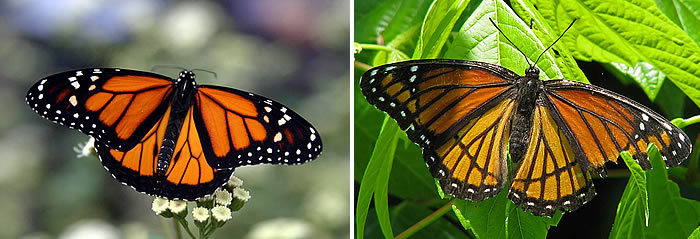 |
| The Viceroy butterfly on the left tastes good to birds. Yet, its similarity to the Monarch butterfly (right) largely protects it from the threats of birds. |
Some animals move extremely slowly and do not have the chance to run away and hide from their enemies. There is yet another defence mechanism given to them: their armours and spikes.
 |
| The hedgehog is the most famous of all the animals that protect themselves with their spikes. The animal, which moves very slowly, would surely have disappeared millions of years ago were it not protected by such a system. The protection method that enables its survival is assuredly neither "thought up" nor "produced" by it, nor brought into existence by coincidence. The animal is simply created like that and that is all. |
 |
| (Left) At an instant of danger, this reptile takes its tail in its mouth and forms a circular shape. Meanwhile, the armour covering its whole body protects it from all kinds of external dangers. (Right) The pill bug rolls inside, takes the shape of a ball at a moment of danger, and is protected, thanks to its strong shell. |
 |
| The pangolin's hard armour looks like a cone. When it curls up, the armour on it pricks up. Almost no animal can open this sharp-edged armour. |
Some animals are protected by their body structures and appearances, which are extremely adaptable to their habitat. Camouflage features Allah bestowed upon those animals are so harmonious with their habitat that when you look at their pictures, you cannot tell whether they are plants or animals. Sometimes you cannot distinguish the animal from its surroundings. The camouflage is so effective and deft that it is obvious that this is a specially designed and "created" defence mechanism.
 |
THE MANTISis one of those insects that are created in harmony with their habitat. They conceal themselves sometimes on leaves, and sometimes on branches. The only weapon they have is the shape and colour of their bodies. In this way, they hide from their enemies. It is quite difficult to distinguish the mantis from the orchid on which it perches |
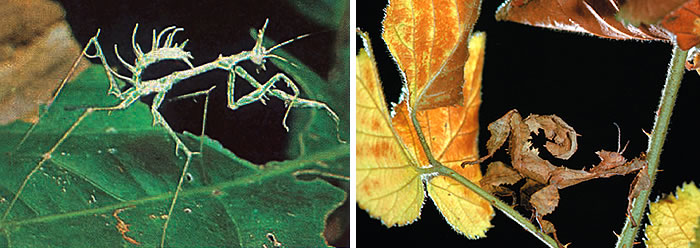 |
| This mantis looks so similar to the leaf it lies on that the butterfly, which has come to take nectar from the flower, has not even noticed it. It certainly has had to pay for this with its life. |
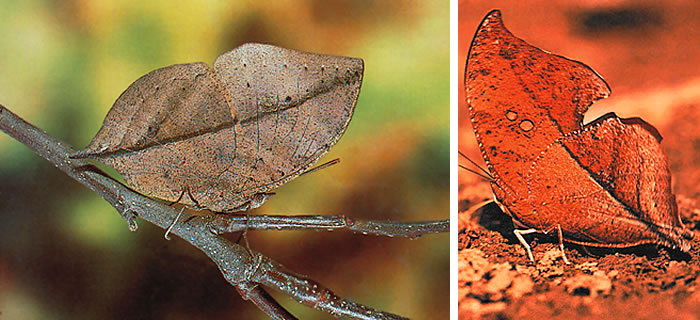 |
| "He is Allah - the Creator, the Maker, the Giver of Form. To Him belong the Most Beautiful Names. Everything in the heavens and earth glorifies Him. He is the Almighty, the All-Wise." |
Is It a Dry Leaf or a Butterfly? |
| At first glance, perceived as dry leaves, these pictures (above and below) actually are of butterflies. The leaf-like wings, which have many details on them - vessels to rotten parts and intonations of colour - provide an excellent protection for the butterflies.It is indeed impossible to overlook this incredible resemblance between the butterfly and the leaf (even the vessels and dried parts of the leaf are not omitted) and call it "chance". Is it not equally nonsense to accept that the butterfly made itself "leaf-like"? |
 |
| Three butterflies camouflaged on tree trunks. |
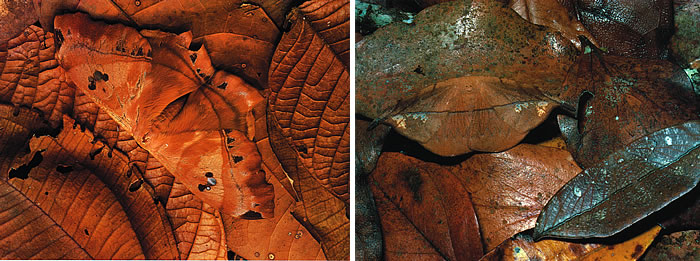 |
 |
| (Left) A caterpillar that resembles bird faeces. The lives of grasshoppers that feed on leaves pass naturally among the leaves. Because the colour of their bodies resembles that of leaves, it is generally not possible for their greatest enemies, lizards and birds, to notice them. Thus, grasshoppers live and feed in safety. No one can claim that grasshoppers were transformed to "become like leaves" because they spent time besides leaves, or that they somehow turned themselves into leaves. It is clear that the leaf-eating grasshoppers were created along with such a camouflage so that they could survive. |
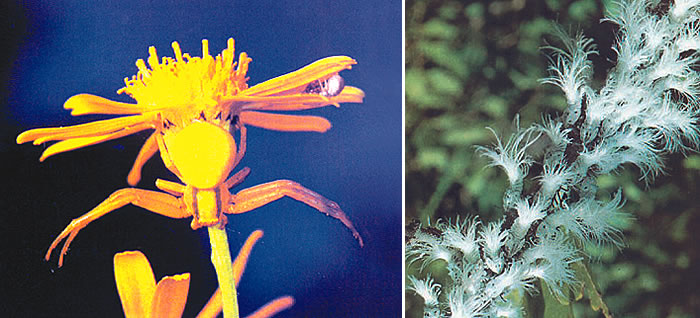 |
| (Left) It is not so easy to distinguish the yellow spider, which has concealed itself in order to hunt flies, from the flower on which it lies. (Right) This branch, which seems as if full with flowers, has only scores of caterpillars on it. |
 |
| (Right) Another example of a creature with camouflage: a frog having exactly the same skin colour as the pattern on the tree trunk. |
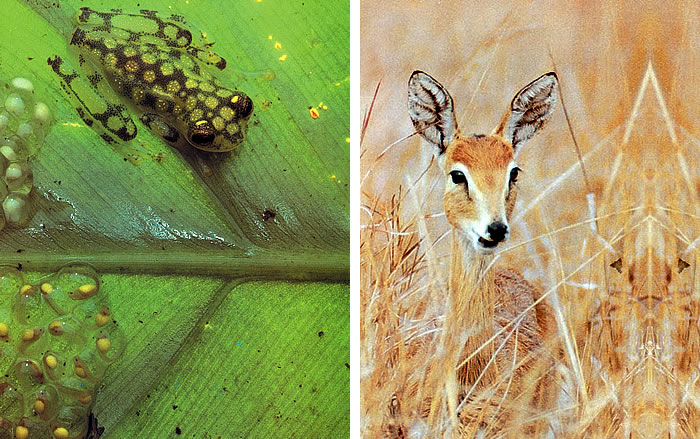 |
| "Is He Who creates like one who does not create? |
| (Right) The colour of the gazelle, which is the same as the pasture, is a great advantage for the animal. |
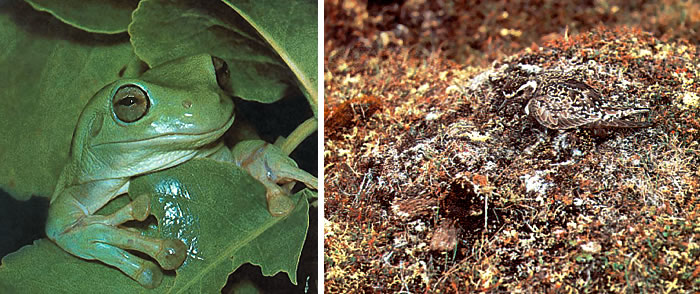 |
| (Left) Green leaves and a green frog. (Right) The colours and patterns of the birds' feathers, birds that nest on the ground, provide them a perfect disguise among the leaves. The eggs of these birds have also the same kind of colours and pattern so that they too can go unnoticed. |
 |
| The snake on the middle can camouflage itself perfectly on the forest floor covered with leaves. The colour of its skin provides it a great advantage during hunting as well as defence. It is quite difficult to distinguish snakes among the leaves. |
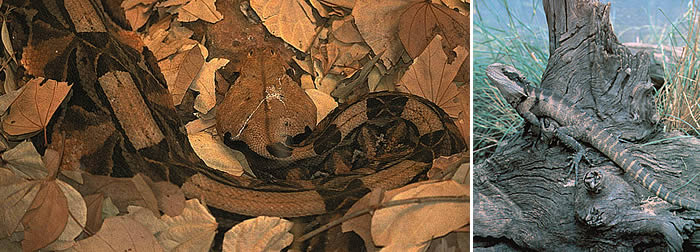 |
| (Right) The wild-looking animal above also carries on its life with the advantages of camouflage. |
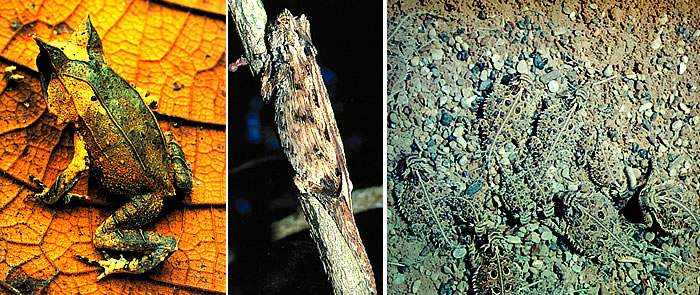 |
| (Right) Among the stones are exactly thirteen horned lizards. |
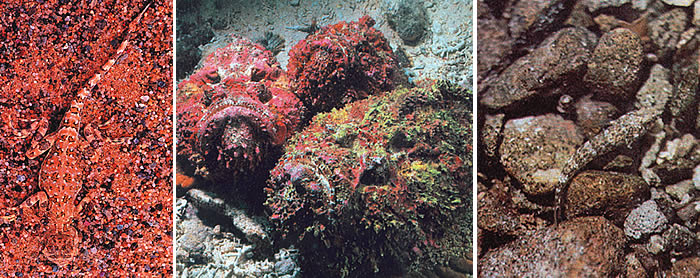 |
| (Left) Gobies appear no different from rocks covered with moss and plankton. |
The characteristic common to the bird at the top and the rabbit at the bottom is that the colours of their feathers change according to the season. These animals put on pure white clothes in winter months whereas they take on a new look in the spring in accordance with the colour of the soil and vegetation.
Changing colours according to habitat is realised through very complex mechanisms in the animals' bodies. These mechanisms, which can be said to resemble the tanning of human skin under the sun, cause colour changes in the coat and fur of the animals. Just as we cannot prevent our body from tanning or burning under the sun (except by utilising special methods of protection), the animals too have no control over the changes in their bodies. The important thing is that this feather change provides a great protection for the animal. Turning white on snowy winter days and ochre in other seasons, its feathers provide great camouflage for the animal.
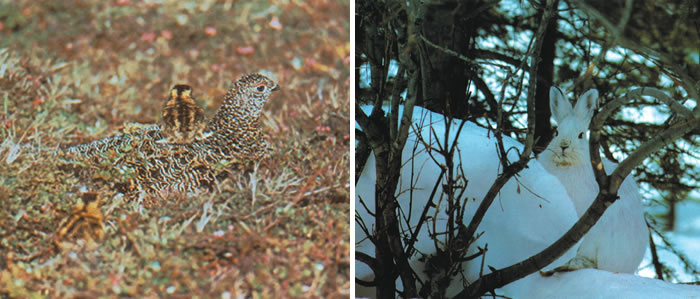 |
It could well have been the reverse; the animal could have been ochre in winter and pure white in summer, or it could never have changed colour. In short, there is an obvious wisdom and calculation in the alternation of the colours according to the seasons. The animal cannot estimate and control this. Certainly the One Who created the animal endowed it with such a protection.
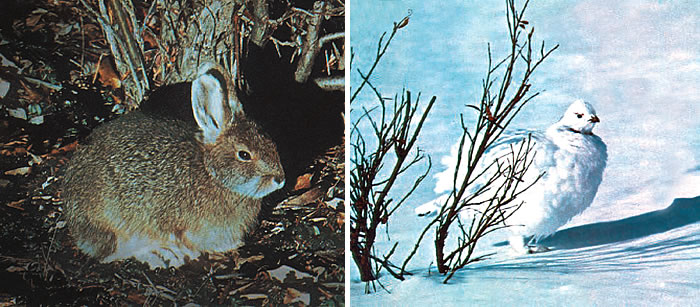 |
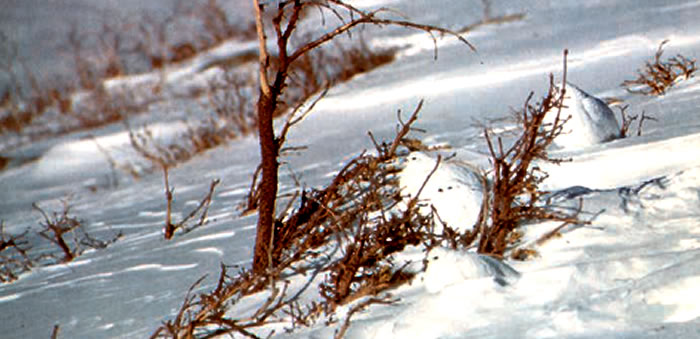 |
The protection of some animals depends on the discouraging effect of red. For instance, in a moment of danger, the tree grasshopper shows the red on its back to its enemy, while crabs disclose the red colour in their pincers. The interesting thing is that the red part in the animal’s body is located in such a place that it is normally not seen yet can easily be disclosed in a moment of danger. This helps it create an "effect which is "shocking" to the attacker.
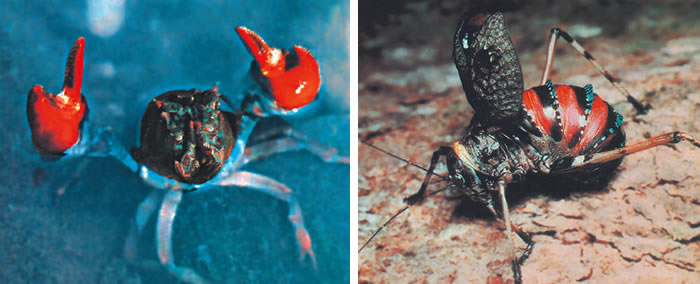 |
 |
 |
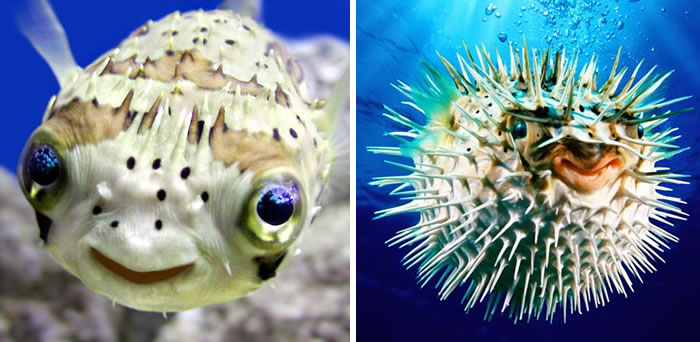 |
The Pufferis equipped with an interesting defence mechanism. This fish, at the moment of danger, swallows a great deal of water and swells up. The spikes jutting out of every part of its body are sufficient to discourage its enemies. |
 |
Seeming More Dreadful Than The Actual |
| In a moment of danger, the lizard in the picture swells itself and makes its body seem far greater than it really is. When it swells up, a mane emerging around its head makes it look even more terrifying. |
Another admirable and amazing method of defence is "false eyes". There are figures on the bodies of some animals that can be called "false eyes". The "false eyes" are so convincing that other animals that wish to hunt these animals cannot escape thinking that they face a much bigger animal. On the other hand, the animals possessing these "false eyes" enjoy the comfort of this trait of which they are not even aware.
When some butterflies open their wings, we encounter a pair of eyes, with all their symmetry and detail. These eyes alone are more than sufficient to convince their enemies that what they face is not a butterfly. Particularly, the false faces of some butterfly species such as the Shonling butterfly, seen below, are so perfect with their shiny eyes, facial features, frowning eyebrows, mouth and nose that the overall picture is quite discouraging to most of its enemies.
It is impossible to claim that this extraordinary picture emerged as the result of "an interesting coincidence". When the below picture is examined in detail, we understand that these facial features cannot have been formed by chance. Can coincidence make symmetry? Can coincidence form the same colours and designs in two different places? Certainly not. This claim is quite meaningless and unscientific.
Could the butterfly possibly make this system on its own, thinking that it would be useful? The answer to that question is certainly "no".
It is out of the question that a caterpillar with a life span of a few weeks could play on its own colours, designs, and make a drawing surpassing even that of artists, and use this for defence purposes.
Like all other living things, Allah also created these beings with "false eyes". The owner of their flawless design is certainly Allah, the Sustainer of all the Worlds.
 |
 |
 |
| False organs work not only for frightening but also for escape. The tail part of the moth in the below picture has the look of a head with antennae. This shape causes attackers to head towards the tail of the moth, taking it for the head. The moth also misleads the attacker by turning its back. This target-confusing operation helps the moth gain time to escape. The same "false head" look is also seen in the butterfly below. |
 |
| Above (left) are the real head and eyes of the thornback ray fish. (Right) The thornback ray fish swims into its nest and leaves its tail outside. On the tail is a pair of "eyes". Other fish around it do not dare to approach it as the false eyes in the tail make them think that it is awake. |
 |
| (Left)This green caterpillar can protect itself from its enemy thanks to the false eyes on its tail. (Right) This bird, which lives in tropical forests, suddenly opens its wings when an enemy attacks its offspring, its eggs or itself. The sudden appearance of two brightly-coloured shapes on the wings proves dissuasive to its enemies. |